

Verdi in Houston
Houston Grand Opera
Presents a Spectacular “AIDA”
May 2007
|
by Harley Schlanger Left, Amneris (Dolora Zajick) tells Aida, kneeling (Zvetelina Vassileva) of her love for Radames. photo by Andrew Cloud |
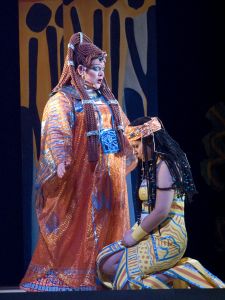 |
|||
Harley Schlanger reviews the Houston Grand Opera's presentation of Guiseppi Verdi's grand opera AIDA in Houston, Texas, April - May 2007.
A Spectacular Aida
Giuseppe Verdi's conception for the opera Aida was that it would be a spectacular event. From the opening notes of the overture, the audience is drawn into a world which is both far away, and yet intimately familiar. An ancient civilization is brought to life on stage, at a moment of existential crisis.
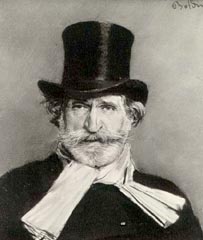 |
||||
|
Giuseppi Verdi, 1813-1901
Composer and Statesman |
||||
The conflicting emotions of patriotism and betrayal, love and rejection, family loyalty versus national duty, give Verdi a rich field from which to produce a variety of recognizable human strengths and frailties.
It should not be surprising that Verdi would be focused on the implications, and complications, for individuals, facing issues of grand strategy -- issues such as war, and matters of church-state relations. The opera premiered in Egypt in December 1871, one month after the convening of the first national Italian parliament in Rome, the culmination of a half-century struggle to establish a unified Italy. Verdi was himself an impassioned patriot and backer of unification, and one can see and hear, in the appeals to patriotism in the opera, the personal commitment he had to the ideal of a united nation.
The performance by the Houston Grand Opera (HGO) succeeded, brilliantly, because the company put its faith in Verdi, in his intricate orchestration, his haunting choruses, powerful arias and ensembles, while simultaneously taking a chance, with an original scenic and costume designer who brought new life to Verdi's Egypt.
HGO'S Triumph
I must admit that I was prepared to dislike the performance in Houston, after reading advance press hype of the vision of eccentric British fashion designer Zandra Rhodes, who designed the set and the costumes. One review described her work, with its emphasis on bright colors, as “punk chic,” while a reviewer for the Independent of London wrote, “Opera fans may wish to take their sunglasses to the theatre.”
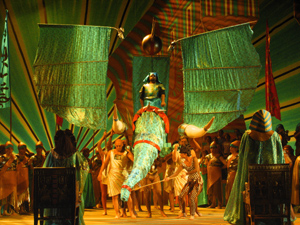 |
|||
| Radames (Marco Berti) returns triumphant from war Photo by Andrew Cloud |
|||
However, the real triumph of the HGO production was its musical virtuosity. The orchestra, under the direction of Carlo Rizzi, was excellent, sustaining the transparent balance required by Verdi, in order to heighten the dramatic tension as the story unfolds. The lead singers were also superb, each coming to this production with an impressive resume of international performances in Verdi's operas. In particular, dramatic soprano Zvetelina Vassileva, a one-time student of the great Carlo Bergonzi, was terrific as Aida. Dolora Zajick as Amneris brought the full range of a Verdi mezzo-soprano to her role, making her character's internal conflict over her love for Radames, even as she participated in his destruction, believable. Marco Berti's Radames captured both the heroism of the military leader, as well as the pathos of the tragic ending he endured.
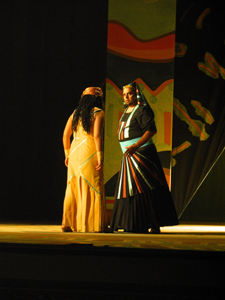 |
|||
| Radames (Marco Berti) assures Aida (Zvetelina Vassileva) that he loves her Photo by Andrew Cloud |
|||
This production, which ran in Houston in April through early May, was a co-production with the English National Opera, the Norwegian National Opera, and the San Francisco Opera. It will be performed later this year in London and Oslo.
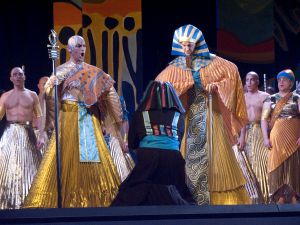 |
||||
| Ramfis (Tigran Martirossian) and the King of Egypt (Bradley Garvin) name Radames (Dongwon Shin, May 5 performance) the leader of the Egyptian army. (Photo by Andrew Cloud) | ||||
![]()
Related Pages
Revolution in Music Pages - Links to Many More Articles
The Genius of Verdi, the Statesmanship of Cavour
Verdi Tuning, the Scientific Pitch at C=256
Schiller Institute Conference at Casa Verdi, 1988
Learn Verdi's Va Pensiero from the Opera Nabucco
Harley Schlanger Reviews Don Giovanni
Music, Book, and Performance Reviews Page
FIDELIO MAGAZINE:
schiller@schillerinstitute.org
The Schiller Institute
PO BOX 20244
Washington, DC 20041-0244
703-297-8368
Thank you for supporting the Schiller Institute. Your membership and contributions enable us to publish FIDELIO Magazine, and to sponsor concerts, conferences, and other activities which represent critical interventions into the policy making and cultural life of the nation and the world.
Contributions and memberships are not tax-deductible.
VISIT THESE OTHER PAGES:
Home | Search | About | Fidelio | Economy | Strategy | The LaRouche Frameup | Conferences
Links | LaRouche | Music | Join | Books | Concerts | Highlights | Education|
Health | Spanish Pages | Poetry | Dialogue of Cultures
Maps | What's New
Copyright Schiller Institute, Inc. 2007. All Rights Reserved.